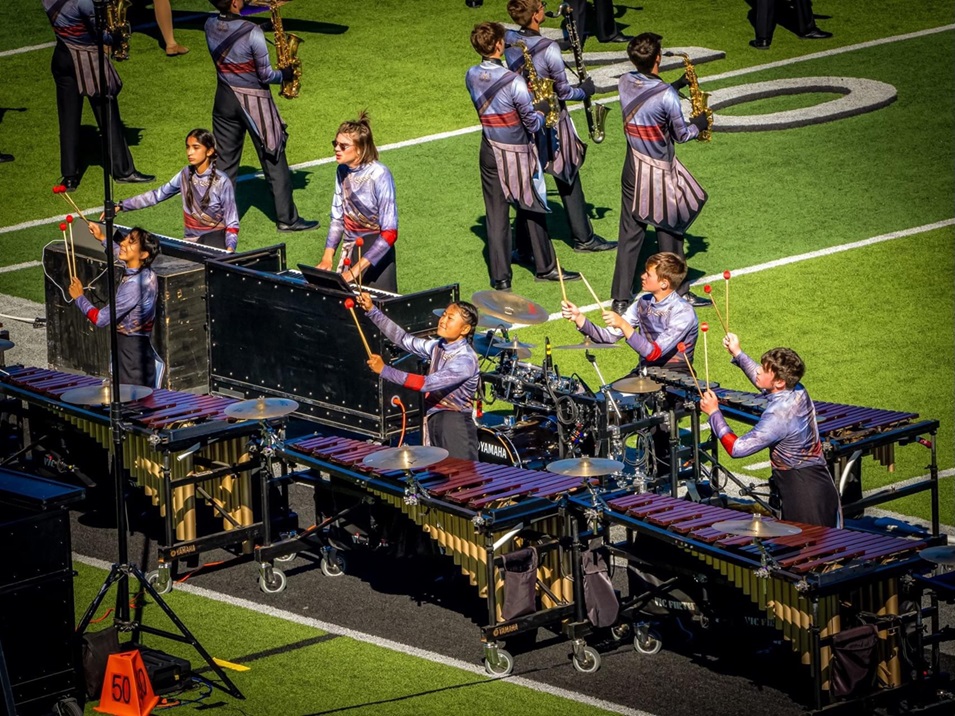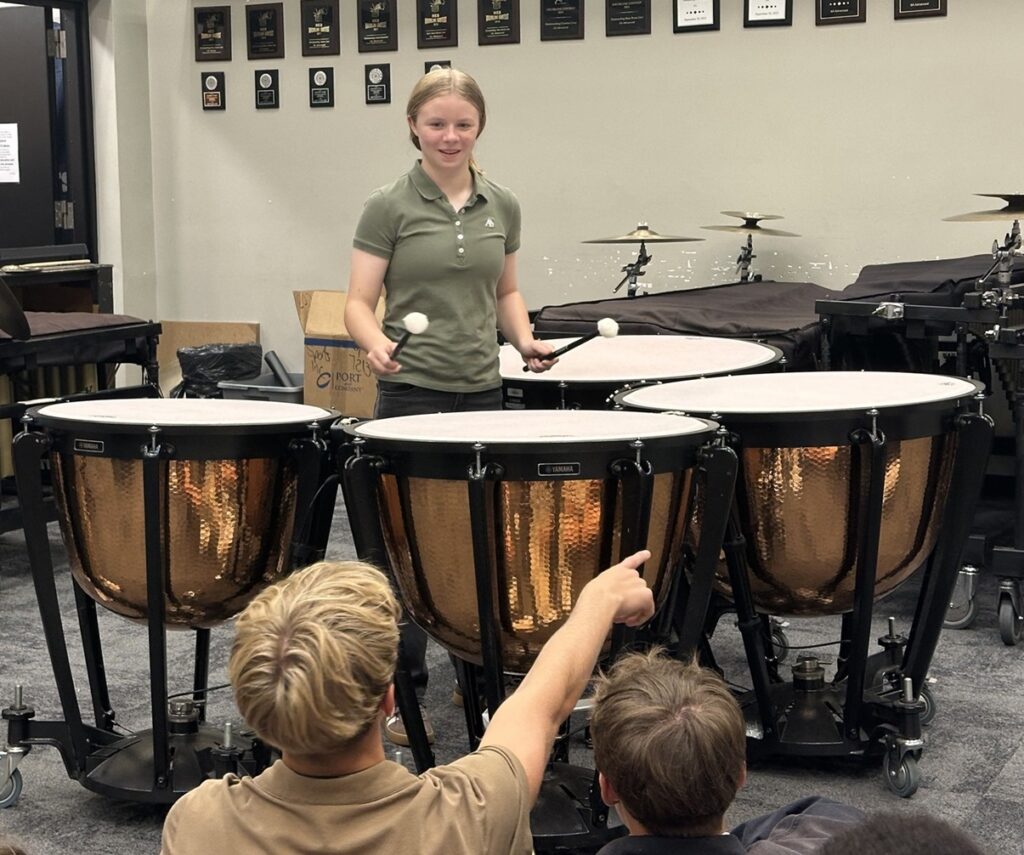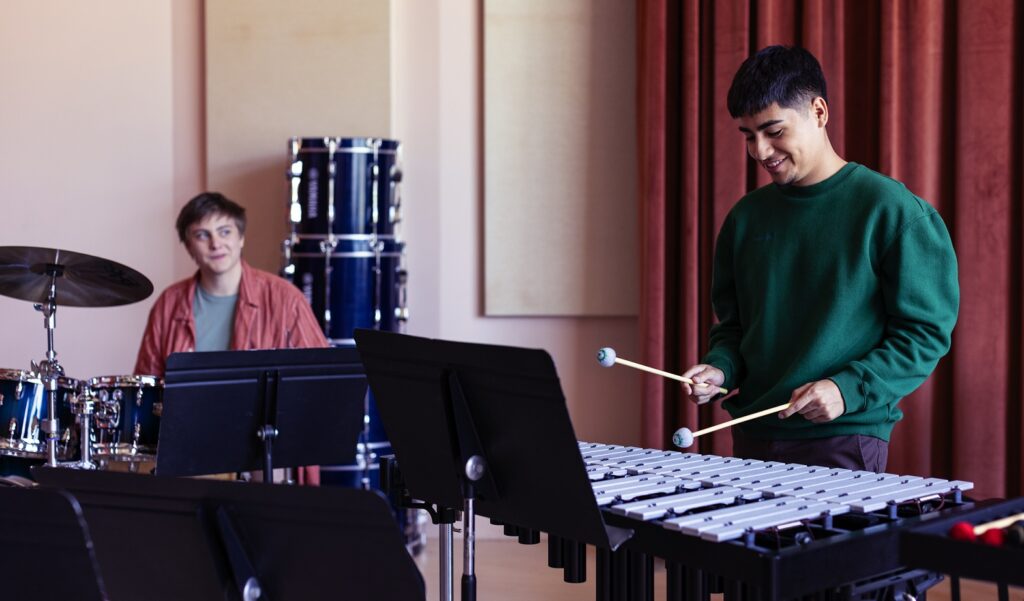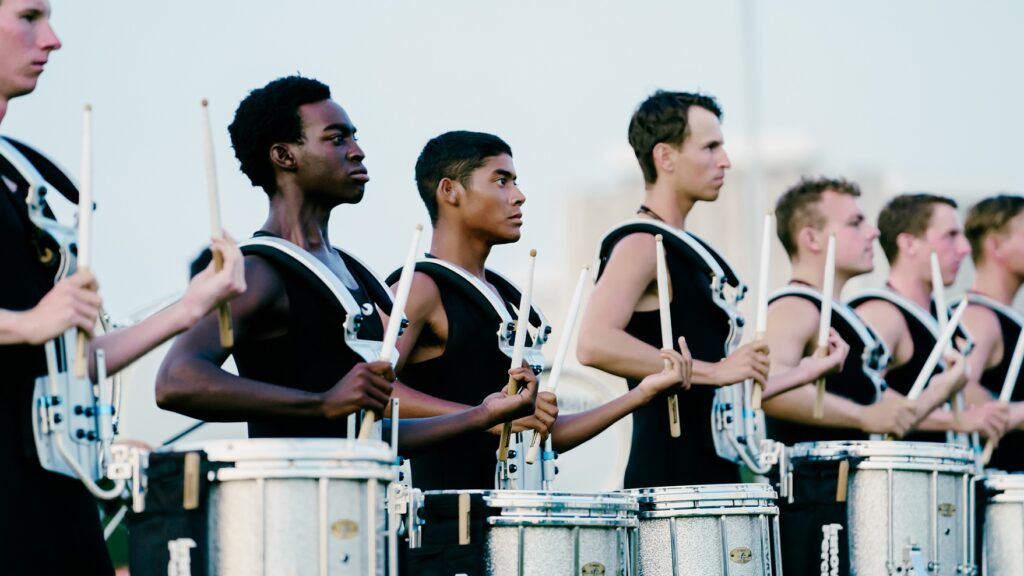Tagged Under:
Drum Set Configuration
Build your kit around your musical level and style. Check out a music educator’s recommendations for beginner, intermediate and advanced players.
When a player sits down at their drum set kit, the configuration they face is more than just a collection of drums and cymbals — it’s a carefully chosen instrument built around the musical style they wish to serve. The chosen gear and setup establish a clear path for growth, comfort and musical identity. Below we’ll explore the logic, benefits and considerations of three levels of drum set configurations while exploring their applicability in common musical genres.

Beginner Setup
At the beginner level, the goal is clarity, comfort and quick traction. A simple, well-balanced kit removes distractions and allows the novice player to build basic coordination, timing and feel. The layout is typically compact, the number of pieces modest, and the hardware stable and forgiving.
This setup is ideal for broad-based styles like pop, rock, country and general contemporary band playing. These genres demand groove, steady time-keeping, straightforward fills and solid foundational beats rather than extreme sonic textures or hyper-complex rack configurations.
Typical components
- 22” kick drum (standard size)
- 12” or 13” rack tom
- 16” or 14” floor tom
- 14” snare drum (standard size)
- 14” hi-hat
- crash cymbal
- ride cymbal
- kick drum pedal and straightforward hardware

With this modest layout, a beginner has access to core tom, snare, bass and cymbal voices without overwhelming choices. A beginner’s kit should foster confidence, so having fewer variables will make practice simpler. With less distractions, the drummer can focus on timing, groove, coordination between hands and feet, and developing a consistent sound.
Genre (rock and country) application
Rock or country music typically requires a strong backbeat on 2 and 4, dynamic contrast for verses and choruses, occasional fills and transitions. The straightforward layout of a beginner’s kit supports these tasks. For example, country drumming often uses simple tom to snare fills, subtle cymbal patterns and crisp hi-hat work. This limited kit keeps the drummer grounded in groove rather than chasing exotic sounds. Meanwhile, for rock, the same kit supports the classic “boom-crash” drive: bass on 1 and 3, snare on 2 and 4, and ride or hi-hat patterns providing momentum.
Setup tips
- Place the rack tom at a comfortable height so the player doesn’t have to reach far.
- Adjust the hi-hat so foot and hand movement are ergonomic.
- Choose medium cymbals (neither extremely bright nor extremely dark) for versatility in multiple styles.
- Teach beginners to tune the drums to a balanced sound (clear toms, snare with some crack, bass drum with some low-end punch) so they learn the value of tone early.

Intermediate Setup
Once the player has gained confidence and can play solid grooves, fills, transition between song sections and adapt to different styles, the next step is an intermediate drum set kit. This configuration expands the sonic palette, provides more toms and cymbals, and allows greater flexibility so the player can explore stylistic nuance and begin to develop a more distinct voice. It bridges the gap toward more specialized setups and helps drummers raise their musicianship.
This level fits genres such as blues‐rock, funk, Americana, modern country and lighter forms of progressive rock. The setup gives the drummer enough variety to color the songs without reaching the complexity required for full-on metal or fusion.
Typical components
- 22” kick drum
- 10” or 12” rack tom plus 14” or 16” second rack tom
- 14” snare drum (experiment with other timbres like a metal shell or hybrid)
- 14” or 15” hi-hat
- 16” and 18” crash cymbals
- 20” or 22” ride cymbal
- optional splash cymbals (10” or 12”) or China cymbals
- double bass pedal for stylistic flexibility
This intermediate kit introduces additional drums and cymbals, enabling more tonal variety, options for fills and dynamic control.
Why this works
With two rack toms and additional floor toms, the intermediate setup gives drummers more melodic percussive possibilities like cascading tom fills, richer transitions and varied drum voices. The extra crash and accent cymbals allow drummers to decorate the groove and build more expressive playing.
Genre (blues-rock, modern country, funk) application
In blues-rock or modern rock settings, you want to drive a song but also add color. For example, a drummer might start on the ride cymbal for the verse, switch to crash then to tom fills for the chorus. The intermediate kit supports that. In modern country, the production often includes fuller drum sounds (more toms, a second crash, maybe splash accents), so the player with an intermediate setup can mimic that studio feel live. For funk and Americana, the extra cymbals and toms help craft more dynamic breaks and melodic tom passages.
Setup tips
- Tune the toms in a descending pitch so the toms sound fluid.
- Place the second crash at a reachable height for comfortable accent transitions.
- If using a splash, mount it near the ride or crash for quick access.
- Maintain ergonomic spacing. With more hardware, it’s easy to over reach so keep the cymbals and toms within comfortable reach to preserve technique.

Advanced Setup
At the advanced level, the drum set becomes a professional instrument tailored for specific genres demanding a wide dynamic range, high quantities of drums and cymbals, advanced coordination and often extreme sonic possibilities. This is the realm of metal, progressive rock, fusion, large-scale live productions and studio drumming, where the drummer is not only keeping time but creating textures, layering rhythmically complex fills, odd time signatures, double bass or multiple pedals, and using exotic cymbals and auxiliary percussion.
Here, the setup becomes strongly genre-linked: a metal drummer’s kit will look very different from a jazz/fusion drummer’s. We’ll focus on rock/metal advanced usage as an example.
Typical components (metal/progressive rock-oriented)
- 24” kick drum (or twin 22” or 18” for extra punch) or dual kick drums
- two rack toms (10” and 12”) plus two or three floor toms (16”, 18”, 20”)
- additional auxiliary drums like a gong drum
- snare with a high budget shell, plus a second snare with an alternate sound
- hi-hat (14” or 15”) plus a secondary hi-hat pedal or remote hi-hat
- large ride cymbal (22”-24”) or multiple ride options, plus multiple crash cymbals (18”, 19”, 20”, 22”) and special cymbals like chinas, splashes and cymbal stacks
- double bass pedal or twin bass drums, multiple pedals
- integration of electronic pads
This very large kit gives maximum flexibility — many voices, many accent points, subtle and extreme tonal options.
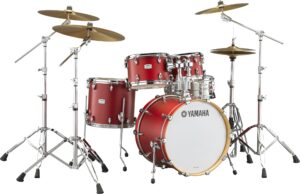
Why this works
In advanced playing environments, the technical requirements are high. The drummer might need to manage rapid double-bass patterns, odd tempo fills, complex interplay with keyboards, guitars or other instruments. The layout must support quick transitions, multiple foot operations and a broad tonal palette because the drummer effectively becomes a multi‐instrument percussionist on a unified kit.
Genre (Metal / Progressive Rock / Modern Studio Drumming) application
For metal, the double bass (or twin bass drums) is essential. Access to multiple floor toms enables thunderous fills and cascading patterns. Many crash and stacked cymbals allow rapid accenting and heavy hit styles. A drummer in a metal band might move from rapid ride patterns to tom runs to crash accents within one passage — an advanced kit supports that. In progressive rock, odd meters and extended instrumental sections demand more voices and flexibility — so, the extra toms and cymbals are musts. For studio drumming across genres, the advanced kit also gives more options to craft sounds for different songs: The drummer can pull from a rich palette rather than being limited.
Setup tips
- Plan for ergonomics and accessibility — with so many drums and cymbals, spacing becomes critical to avoid fatigue.
- Use angled rack toms descending in height and increasing in size to create fluid fill motion.
- For double bass, place pedals and secondary drums such that both feet can reach comfortably to ensure smooth solo fills.
- Keep primary ride and crash cymbals within easy reach and place special cymbals slightly farther away, but still accessible without overextending.
- Consider sound isolation, room acoustics and potential triggers or electronic integration if playing in large venues or recording.
- Maintain a consistent tuning plan: With many toms, keeping tones coherent is key for a professional sound.

Putting It All Together
The beauty of this tiered approach is that drummers move to larger, more complex kits as their skills grow. By building from a beginner kit through intermediate to advanced, drummers develop technical facility, musical feel, tuning sense, ergonomic habits and a personal sound. In educational terms: Start with fundamentals then expand the toolkit then specialize and refine.
In beginner mode, drummers internalize groove, tempo, coordination and basic fills. At the intermediate level, they begin to explore stylistic nuance, embellishment, dynamic contrast and interplay. At the advanced level, they use the kit as an expressive vehicle — capable of supporting high tempo, complex arrangements, dramatic transitions and genre-specific demands.
For each genre, the kit reflects the musical language. A country drummer wouldn’t typically need three floor toms and multiple Chinas; the simpler kit serves the musical story. A funk drummer might benefit from an intermediate kit to accent chops and ghost notes. A metal drummer practically demands the advanced layout to keep up with the intensity.
Moreover, the progression through kit sizes fosters good habits: tuning, setup ergonomics, cymbal choice, seat height, pedal technique and stick trajectory — all of which are easier to manage and refine when the setup is appropriately scaled for the player’s level.
A drum kit is not gear, it’s a musical instrument. The size, number of drums, cymbals, pedals and accessories define what the drummer can do, how they respond to the music, and how they present themselves in the band context.

Final Thoughts
If you are guiding a student drummer (or are one yourself), think about the musical style you aim to play, the venues you’ll play in, the grooves you’ll support and the transitions you’ll navigate. Use that to inform your kit choice. Just as educators craft smart learning plans and ensemble frameworks to steer student growth, you can craft your drum‐kit roadmap: Start simple, learn your fundamentals, expand your kit as your skills and musical ambitions grow, and match your setup to the style you want to serve.
In short: Choose the right kit for your level and genre, tune it well, set it up ergonomically and let the instrument reflect your musical identity.










